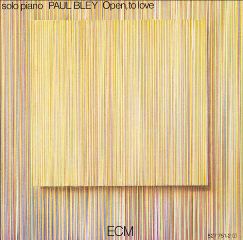Paul Bley - Open, to Love (1972)
Paul Bley - Open, to Love (1972)

1. "Closer" (Carla Bley) - 5:55 2. "Ida Lupino" (Carla Bley) - 7:35 3. "Started" (Paul Bley) - 5:21 4. "Open, to Love" (Annette Peacock) - 7:14 5. "Harlem" (Paul Bley) - 3:26 6. "Seven" (Carla Bley) - 7:25 7. "Nothing Ever Was, Anyway" (Annette Peacock) - 6:02 Paul Bley – piano
Despite the fact that pianist and composer Paul Bley had been a renowned and innovative jazzman for nearly 20 years, 1973 saw the release of his most mature and visionary work, and one that to this day remains his opus. This is one of the most influential solo piano recordings in jazz history, and certainly one that defined the sound of the German label ECM. Consisting of seven tracks, five of which were composed by Carla Bley (his ex-wife) and Annette Peacock (soon to be his ex-wife), and two originals, Bley showcased his newfound penchant for the spatial pointillism and use of silence that came to define his mature work. In Carla Bley's "Ida Lupino," the pianist took the song's harmonics and unwound them from their source, deepening the blues elements, brushing the Errol Garnerish ostinato with pastoral shades and textures of timbral elegance, and reaching the tonic chords in the middle register just as he forced the improvisation just barely into the abstract with his right hand, percussively slipping in one or two extra notes to highlight the deep lyricism in the tune's body. On his own "Started," Bley illustrates brazenly the deep influences of the Second Viennese School on his sense of harmony and counterpoint.
Recalling Arnold Schöenberg's solo piano pieces in their engagement of dissonance and glissando placement, it's still Bley playing jazz and improvising, vamping on his own theme while turning melody and timbre back on themselves for the purpose of complete tonal engagement in the middle register. And in Annette Peacock's "Nothing Ever Was, Anyway," which closes the album, Bley makes full use of an element he employs throughout the recording: space and its ability to create the notion of consonance or dissonance from the simplest of melodies. Here notes appear, related, but just barely, to one another in a more or less linear sequence, and Bley stretches that connection to the breaking point by using his sense of spatial relationship in harmony to silence. He elongates the tonal sustain and allows it to bleed into his next line just enough, as if it were a ghostlike trace of another melody, a another distant lyric, attempting to impose itself on the present one, though it had just since ceased to exist. Ultimately, what Bley offers is jazz pianism as a new kind of aural poetics, one that treats the extension of the composer's line much as the poet treats the line as the extension of breath. Sheer brilliance. ---Thom Jurek, Rovi
download: uploaded 4shared ziddu anonfiles sugarsync mediafire mixturecloud gett








